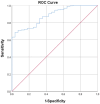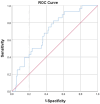Negative and Positive Predictors of Anastomotic Leakage in Colorectal Cancer Patients-The Case of Neutrophil-to-Lymphocyte Ratio
- PMID: 39202294
- PMCID: PMC11353382
- DOI: 10.3390/diagnostics14161806
Negative and Positive Predictors of Anastomotic Leakage in Colorectal Cancer Patients-The Case of Neutrophil-to-Lymphocyte Ratio
Abstract
Colorectal surgery for cancer is associated with a high rate of surgical complications, including anastomotic leakage. The ability to predict the risk of leakage early enough seems to be of high value, since it would facilitate the design of personalized treatment and duration of hospitalization. Although different studies present the neutrophil-to-lymphocyte ratio [NLR] as having a strong predictive value, there is a discrepancy with respect to which postoperative day is the most reliable. We evaluated a series of NLR values, from the day before surgery up to the POD7, in a cohort of 245 colorectal surgery patients in order to clarify the best predictable score for the identification of the risk of anastomotic leakage. There were 28 patients with leaks. ROC curve analysis of NLR on POD1 indicates that a cut-off point ≥ 7.4 exerts a negative prediction for leakage (AUC 0.881, sensitivity 68.7%, specificity 96.4%, PPV 28.4%, and NPV of 99.3%), thus excluding 150 patients from the risk of leakage. Furthermore, the ROC curve analysis of NLR on POD4 indicates that a cut-off point ≥ 6.5 gives a positive prediction of leakage (AUC 0.698, sensitivity 82.1%, specificity 51.6%, PPV 17.6%, and NPV of 95.6%), thus indicating 52 patients as being at high risk of leakage. Finally, NLR failed to identify five leaks out of twenty-eight. These results strongly indicate the ability of NLR on POD1 to predict patients at low risk of developing a leak and then on POD4 to predict the high-risk patients. This makes our study particularly innovative, in that it enables doctors to concentrate on potential high-risk patients from POD1.
Keywords: anastomotic dehiscence; anastomotic leak; anastomotic leakage; colorectal cancer; lymphocytopenia; neutrophil-to-lymphocyte ratio (NLR); prognostic factor.
Conflict of interest statement
The authors declare no conflicts of interest.
Figures







Similar articles
-
Neutrophil to Lymphocyte Ratio and C-Reactive Protein as Two Predictive Tools of Anastomotic Leak in Colorectal Cancer Open Surgery.Dig Surg. 2018;35(1):77-84. doi: 10.1159/000456081. Epub 2017 Jan 28. Dig Surg. 2018. PMID: 28132052 Clinical Trial.
-
[The clinical values of neutrophil-to-lymphocyte ratio as an early predictor of anastomotic leak in postoperative rectal cancer patients].Zhonghua Zhong Liu Za Zhi. 2020 Jan 23;42(1):70-73. doi: 10.3760/cma.j.issn.0253-3766.2020.01.011. Zhonghua Zhong Liu Za Zhi. 2020. PMID: 32023773 Chinese.
-
The value of perioperative neutrophil-to-lymphocyte ratio combined with the prognostic nutritional index for predicting anastomotic leakage after minimally invasive esophagectomy.J Thorac Dis. 2025 Mar 31;17(3):1673-1683. doi: 10.21037/jtd-2025-302. Epub 2025 Mar 27. J Thorac Dis. 2025. PMID: 40223988 Free PMC article.
-
[C-reactive protein as early predictor of anastomotic leakage after surgery for colorectal cancer. Systematic review and meta-analysis].Khirurgiia (Mosk). 2020;(8):82-87. doi: 10.17116/hirurgia202008182. Khirurgiia (Mosk). 2020. PMID: 32869620 Russian.
-
Predictive Factors for Anastomotic Leakage Following Colorectal Cancer Surgery: Where Are We and Where Are We Going?Curr Oncol. 2023 Mar 7;30(3):3111-3137. doi: 10.3390/curroncol30030236. Curr Oncol. 2023. PMID: 36975449 Free PMC article. Review.
Cited by
-
Clinical Significance of Blood Cell-Derived Inflammation Markers in Assessing Potential Early and Late Postoperative Complications in Patients with Colorectal Cancer: A Systematic Review.J Clin Med. 2025 Apr 7;14(7):2529. doi: 10.3390/jcm14072529. J Clin Med. 2025. PMID: 40217978 Free PMC article. Review.
References
-
- Frasson M., Flor-Lorente B., Rodríguez J.L., Granero-Castro P., Hervás D., Alvarez Rico M.A., Brao M.J., Sánchez González J.M., Garcia-Granero E. Risk Factors for Anastomotic Leak After Colon Resection for Cancer: Multivariate Analysis and Nomogram from a Multicentric, Prospective, National Study with 3193 Patients. Ann. Surg. 2015;262:321–330. doi: 10.1097/SLA.0000000000000973. - DOI - PubMed
-
- Tan F., Xu K., Qi X., Gao P., Liu M., Yao Z., Zhang N., Yang H., Zhang C., Xing J., et al. Neutrophil-to-Lymphocyte Ratio as an Early Predictor of Symptomatic Anastomotic Leakage in Patients after Rectal Cancer Surgery: A Propensity Score-Matched Analysis. J. Pers. Med. 2022;13:93. doi: 10.3390/jpm13010093. - DOI - PMC - PubMed
-
- Paliogiannis P., Deidda S., Maslyankov S., Paycheva T., Farag A., Mashhour A., Misiakos E., Papakonstantinou D., Mik M., Losinska J., et al. Blood cell count indexes as predictors of anastomotic leakage in elective colorectal surgery: A multicenter study on 1432 patients. World J. Surg. Oncol. 2020;18:89. doi: 10.1186/s12957-020-01856-1. - DOI - PMC - PubMed
LinkOut - more resources
Full Text Sources

